Author: Daniel Li, CoinVoice
On June 30, 2025, in Cannes, France. On stage, Robinhood CEO Vlad Tenev announced a series of eye-catching new moves: the Robinhood Chain built on Arbitrum, tokenized U.S. stock trading, perpetual futures, ETH/SOL staking, private equity token subscriptions, and the Rabbit Gold Card, which directly converts off-chain consumption cashback into crypto assets. The launch event was called 'To Catch a Token', but what it truly aimed at was the critical point of the entire traditional financial system. Following the announcement, Robinhood's stock price soared nearly 10%, and its market value exceeded $76 billion, igniting enthusiasm among both crypto market and U.S. stock investors.
From 'zero commission' disruptor to on-chain financial reconstructer, Robinhood is embedding itself deep within the global financial architecture. This is no longer just an upgrade path for a brokerage, but a strategic shift that spans technology, products, regulation, and traffic entry points. Against the backdrop of the Trump administration's push to relax crypto regulation in the U.S. and the global surge in asset tokenization, Robinhood aims to be the first to run through a complete set of 'tokenized U.S. stocks + private equity + native Layer2' closed loop, establishing a new order that supports 7×24 on-chain trading and asset issuance.
This article will be divided into three parts, starting from Robinhood's growth trajectory and gradually dissecting how this 'new financial giant' leverages blockchain technology and compliance advantages to evolve from a 'cheap and easy-to-use' brokerage to a core player in the wave of tokenized U.S. stocks.
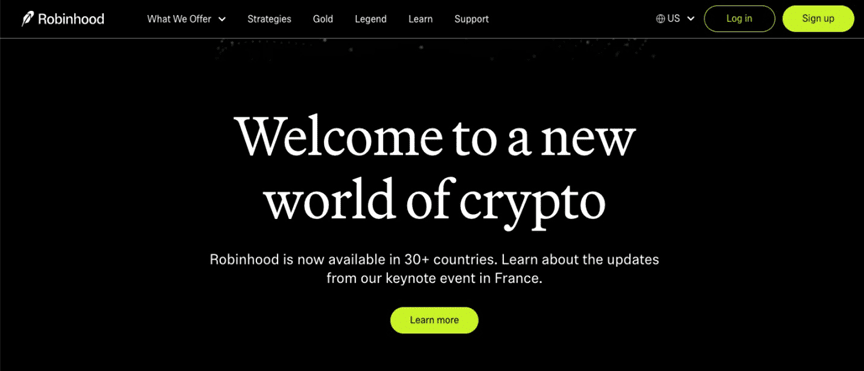
Robinhood's Rise: From Zero Commission Innovation to the Beginning of an On-chain Financial Ecosystem
In 2013, two graduate students from Stanford University, Vlad Tenev and Baiju Bhatt, inspired by the 'Occupy Wall Street' movement, keenly observed the structural inequities within the traditional financial system: institutional investors enjoy trading privileges due to technological and cost advantages, while ordinary retail investors are blocked by high commissions and complex thresholds. With the ideal of 'financial democratization', the two founders, born in the 90s, set out to create a radical product that accurately addressed user pain points—Robinhood. In 2015, the app was officially launched, quickly gaining popularity with its zero-commission, no-threshold securities trading service. During the early testing phase, it attracted over 50,000 reservations, and the waiting list exceeded one million before the official release. By 2018, the number of registered users had reached 4 million, surpassing the 36-year-old traditional brokerage E*TRADE, heralding the arrival of the internet securities platform era.
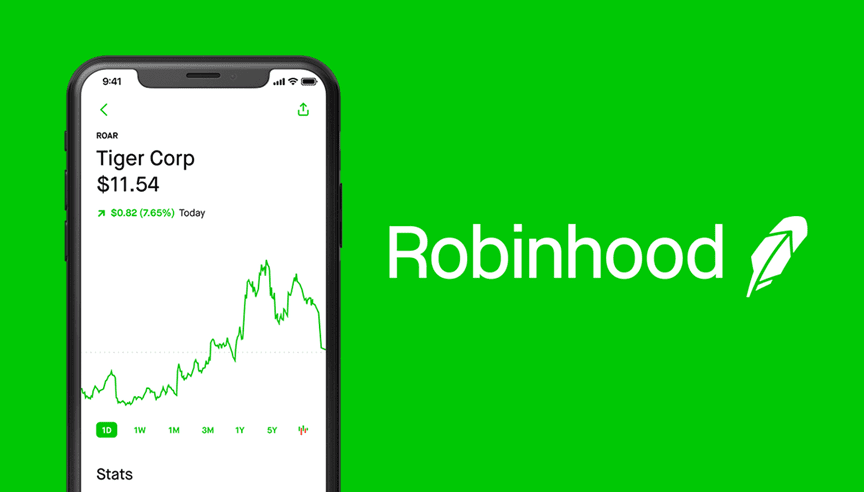
As the business model matures, Robinhood's corporate positioning is gradually upgrading from a 'free securities platform' to a 'new generation financial gateway'. As of the first quarter of 2025, the platform's deposit users reached 25.8 million, with a quarter-on-quarter growth of over 8%; total client assets increased to $221 billion, and the average assets managed per user reached $8,566, setting a historic high. This leap not only enhances Robinhood's asset-bearing capacity but also marks the transition of its user structure from 'novice retail investors' to 'mainstream middle-class investors'. Notably, the number of paid members, Robinhood Gold, surpassed 3.2 million in Q1 2025, with a year-on-year growth of 90%, fully demonstrating its penetration rate and asset stickiness among the young high-net-worth user group.
However, Robinhood's ambitions go far beyond simply 'putting assets on-chain'; it is attempting to build a complete ecosystem for on-chain asset management, moving towards a positioning as a 'crypto version of Fidelity', a one-stop platform. As early as 2022, this strategic outline began to take shape. That year, Robinhood was the first to launch a non-custodial wallet, Robinhood Wallet, allowing users to freely store and access BTC and ETH, and to connect with mainstream DeFi protocols; in 2023, it further opened on-chain asset withdrawals, breaking down centralized account barriers; in 2024, it acquired the oldest compliant exchange in Europe, Bitstamp, for $200 million, obtaining over 50 financial licenses in the UK, EU, Singapore, and integrating its deep liquidity network and all-weather trading engine covering over 5,000 institutions. This transaction not only significantly compressed the compliance cycle but also packaged Robinhood's institutional service capabilities and global compliance framework for a seamless entry into on-chain finance.
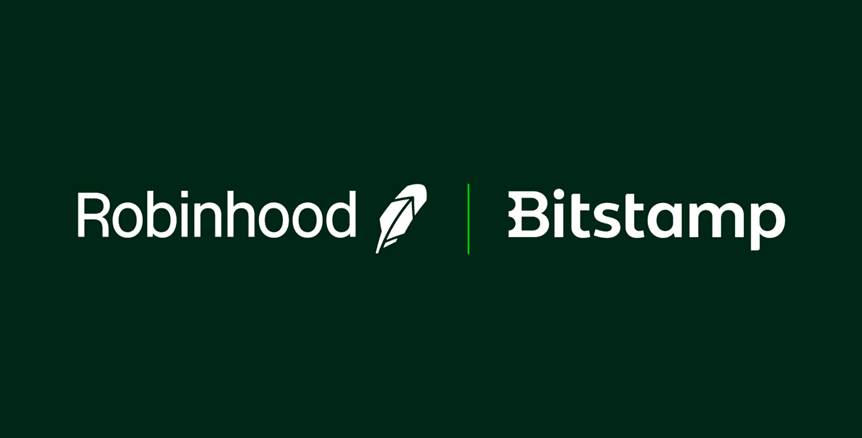
From zero commission to crypto expansion, Robinhood has always been at the forefront of the industry, and these strategic changes have quickly brought real returns. The Q1 2025 financial report shows that the company's total revenue reached $583 million, with the crypto business contributing as much as $252 million, accounting for 43%, surpassing options ($240 million) and stock trading ($184 million) for the first time, becoming the main source of income. This not only reflects the rapid growth of new businesses such as tokenized stocks but also signifies that Robinhood has initially mastered three core capabilities: crypto trading entry, liquidity engine, and financial service closed loop. As founder Tenev has repeatedly emphasized, 'Robinhood's ultimate mission is not to become a replica of Wall Street, but to build an on-chain financial bottom system that everyone can access.'
Robinhood's Leap: Opening the New Era of Tokenized U.S. Stocks and Global On-chain Investment
On June 30, 2025, at the 'To Catch a Token' launch event held in Cannes, France, Robinhood officially pushed its crypto strategy to a climax and clearly defined its segmented market layout and product system for the first time. The core strategy announced at the conference focuses on Europe as a forward base, revolving around 'tokenized U.S. stocks + perpetual contracts + All-in-One investment App'. Technically, Robinhood announced that over 200 U.S. listed stocks and ETFs have completed tokenization and have been launched on Arbitrum Layer2, allowing users to conduct real-time trading 24/5 within the app. On-chain dividend and stock split synchronization mechanisms have also been initiated to ensure users have real rights. By the end of the year, Robinhood plans to expand to thousands of underlying assets, aiming to create the world's most liquid and least barrier-to-entry on-chain securities market.

In line with this strategy, Robinhood has fully upgraded its original European app 'Robinhood Crypto' to 'Robinhood', officially establishing itself as a one-stop comprehensive investment platform. In addition to the existing cryptocurrency trading functions, the platform is set to launch perpetual contract trading in the summer of 2025, with liquidity and clearing support provided by Bitstamp. The mobile UI designed for European users is extremely simplified, with profit taking, stop loss, and leverage settings all completed through sliders, significantly reducing the learning costs for non-professional users and achieving 'on-chain derivatives democratization' for the first time.
At the same time, Robinhood has also opened private token subscription for high-potential startups such as SpaceX and OpenAI, allowing eligible users to receive tokens within the application. These tokens will be issued on a 1:1 basis based on real equity, providing ordinary users a way to directly participate in private equity for the first time in the form of digital assets. This breakthrough changes the market structure originally dominated by high-net-worth investors and institutions, promoting 'private equity democratization' in the crypto context. To encourage participation, Robinhood has also established a '2% deposit reward' incentive mechanism, aiming to maximize the activation of the European market's forward value in the tokenization reform.
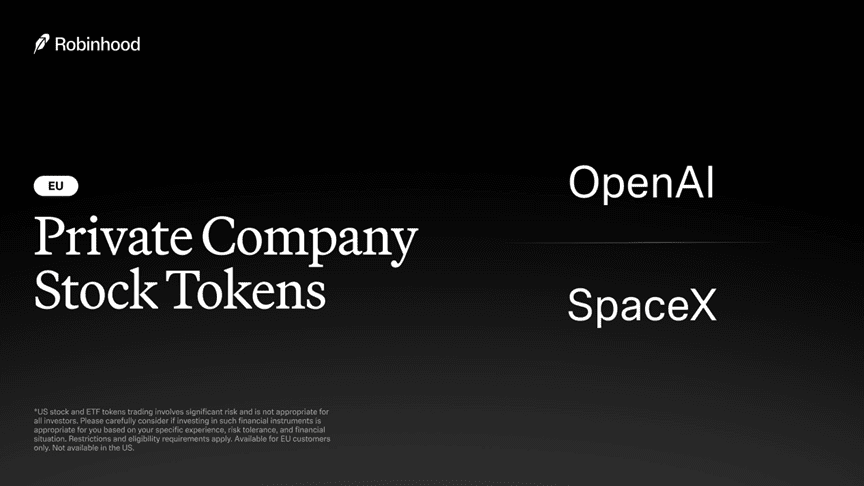
In addition to Europe, the U.S. market, as the core base for Robinhood users, has also been given the role of 'upgraded on-chain experience' in this launch event. The first batch of products includes ETH and SOL staking services, fully open in the U.S. market, removing minimum amount restrictions and offering a 2% deposit reward. Robinhood emphasizes that staking is not only a tool for generating income but also part of user participation in network building. Meanwhile, Robinhood's AI investment assistant Cortex was officially unveiled at the event. This assistant will primarily serve Robinhood Gold users, integrating on-chain data, token news, whale trading, and financial events to generate personalized strategy suggestions and risk alerts.
Behind the entire technology stack, Robinhood's self-developed 'Robinhood Chain' has become a key infrastructure. This Layer2 public chain built on the Arbitrum technology stack is defined as the first native chain serving real assets (RWA). Its three-phase advancement path is clear: the first phase is completed by Robinhood for U.S. stock procurement and 1:1 token minting; the second phase will incorporate Bitstamp into the trading system, ensuring that token assets still have liquidity during traditional market closures; the third phase will fully open self-custody and cross-chain migration capabilities for assets, achieving true asset sovereignty. Robinhood has stated that the public chain will begin testing by the end of the year and fully launch in 2026. At that time, Robinhood will officially evolve from a traditional brokerage platform into a key access layer for the digitalization of global real assets.
Robinhood's Breakthrough: Compliance Risks and Challenges of Multidimensional Competition
In the journey towards global tokenized finance, Robinhood's primary challenge is the complex and severe policy gap. The U.S. Securities and Exchange Commission (SEC) has yet to establish a clear legal framework for securities-type tokens. Robinhood's Chief Compliance Officer, Anna Lee, has candidly stated at various industry forums: 'The compliance of tokenized U.S. stocks, especially at the intersection of traditional securities regulations and blockchain innovation scenarios, still carries many uncertainties and regulatory risks.' When promoting the tokenization of stocks, ETFs, and private equity, Robinhood needs to find a balance between existing securities laws and emerging blockchain applications, avoiding regulatory red lines while driving technological innovation. Although the U.S. House of Representatives passed the (RWA asset registration and compliance exemption bill) in 2024, this bill has yet to enter the Senate for a vote, making it difficult for Robinhood to obtain comprehensive legal protection in the short term.
The European market has relatively mature regulation but still faces challenges. The EU's (Markets in Crypto-Assets Regulation) (MiCA) has set a framework for crypto asset regulation, but the specific classification and compliance standards for tokenized securities are still being refined. Robinhood must not only deal with regulatory differences across countries but also handle complex issues such as cross-border KYC/AML, investor suitability, and tax reporting, leading to high compliance costs and complex execution. David Chen pointed out: 'We operate in multiple jurisdictions globally, and every detail must be rigorously controlled, as this is not only about compliance but also the cornerstone of maintaining user trust.'
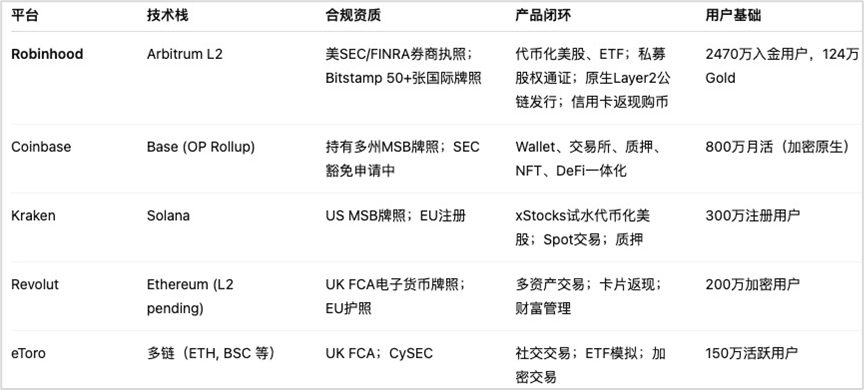
Industry competition is also becoming increasingly fierce. Coinbase has built a complete ecosystem using Base Layer2, integrating wallets, trading, staking, and DeFi protocols, with a large native crypto user base and an active developer community; Kraken's xStocks project is testing a small number of U.S. stock tokens on the Solana chain, although liquidity is still shallow, it attracts high-frequency traders due to extremely low latency; the European markets' Revolut and eToro are deeply cultivating a 'financial supermarket' and 'social trading + ETF simulation' model, balancing crypto trading with investment education, becoming strong competitors to Robinhood in comprehensive investment services. Facing multidimensional competition, Robinhood must not only maintain a technological edge but also build insurmountable barriers through compliance and user experience.
Robinhood has currently built a triple core moat. First, as a licensed securities broker in the United States, Robinhood possesses the legal qualifications for securities issuance and trading, providing a solid legal guarantee for tokenized securities. Second, the acquisition of Bitstamp has brought over 50 international regulatory licenses and access to liquidity resources from more than 5,000 institutional clients, ensuring that the token market can remain active and deep during traditional exchange trading hours. Finally, Robinhood has tens of millions of monthly active users, especially establishing a strong brand recognition among the younger generation of investors. The Rabbit Gold Card credit card's crypto cashback feature has achieved a seamless connection between off-chain consumption and on-chain asset management, creating a great user experience without the need for users to feel the on-chain process.
Despite facing multiple challenges such as unclear regulatory policies, intensified industry competition, and fragmented technological ecosystems, Robinhood is striving to build a global digital financial hub for 'tokenized U.S. stocks' and diversified RWAs, thanks to its compliant qualifications, deep institutional liquidity network, and large user ecosystem. As Anna Lee stated, compliance and innovation are not opposites but are the twin engines driving Robinhood forward. In the future, Robinhood hopes to achieve a 'borderless on-chain financial experience' where users do not need to perceive the underlying complexities, truly making digital assets a daily wealth tool accessible to global investors.



